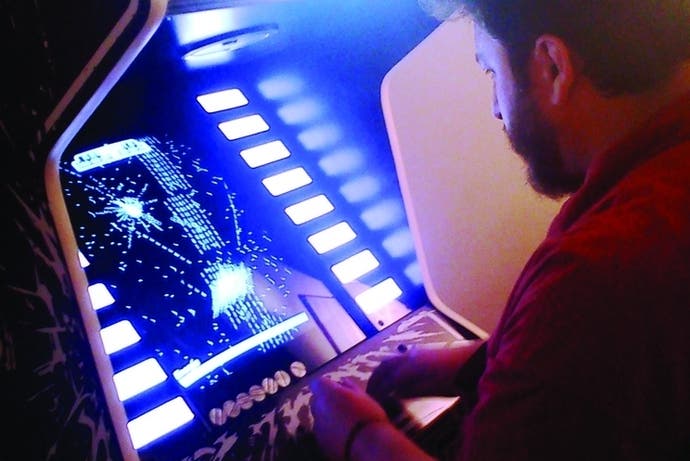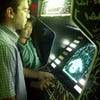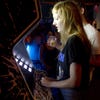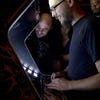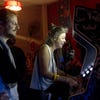The legend of Nave, the Argentinian arcade cabinet
How two friends rediscovered the arcades in Buenos Aires.
Finding an arcade game in the wild anywhere in the world is reason enough for celebration, be it a tired-looking Neo Geo cabinet too bulky for anyone to bother moving that's resolute in the corner of a chippie or a Numan Athletics that sits unplayed in a run-down casino, cast in the dreary blinking light of a dozen fruit machines. If you ever manage to stumble upon a Nave cabinet, however, consider it a red-letter day: there's only one in existence, and it's never ventured beyond the borders of Argentina.
It's a curious, eccentric creation, the brainchild of a curious and eccentric pair. Hernan Saez and Maximo Balestrini, two residents of Buenos Aires, are an unlikely couple. Balestrini, you get the impression after a late afternoon's chat, is the orderly core of this unlikely pairing, a systems engineer who's also got a flair for creating websites. Saez, meanwhile, is the more erratic, more eccentric half: a filmmaker, editor and sometimes actor who's made fantasy, action and horror shorts; he's always happy to chase down a fleeting metaphysical thought. Balestrini, it seems, is always there to make sense of it all.
The two met through a shared love of videogames (on the set of a zombie film, their official story goes, although Saez tells me it's because he used to go out with Balestrini's sister, a truth that's ironically not quite so romantic). They then did what any smart, enterprising pair would do: they set about creating a game themselves, a feat that isn't necessarily so straightforward in a country with no recognized industry in the form.
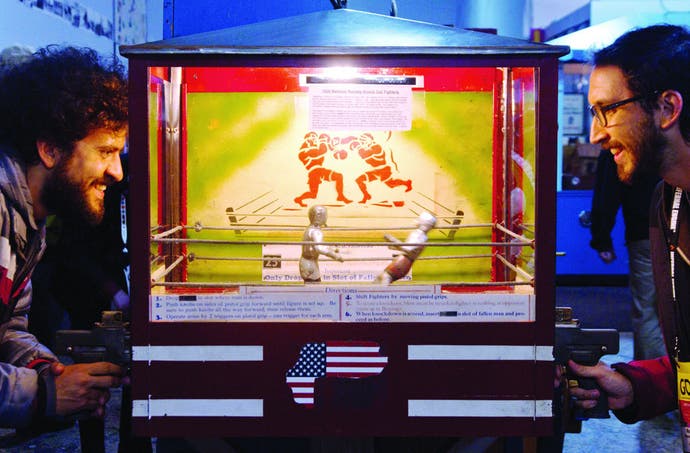
"That's true," says Saez. "There are no important video games or anything like that. Right now the industry's most of all companies working for companies abroad. Making advergames, or Facebook games. Right now there are some companies starting to make their own games for iOS, a couple of indie game makers, but that's it. It's too expensive."
Games aren't necessarily made in Argentina, but they're most definitely played there - and a childhood in Buenos Aires for someone obsessed with video games has the same reference points as a similarly preoccupied childhood in London. "I played a lot of videogames when I was growing up in the vacations," says Saez. "There was stuff like the Commodore, and also some Coleco and Atari stuff. Maybe it's the same history."
"There was a restaurant that had an arcade nearby," Balestrini recalls. "When my father was there, I ran to the arcade." It's a heritage the two share. "I learnt a lot going to the arcades, but I used to watch a lot," says Saez. "My parents never game me much money, so I used to watch - and then look for missing coins and tokens. Sometimes I used to play Moon Patrol, because it was one I had on my Commodore, and I didn't want to use that credit so fast."
It makes sense, then, that when the two decided to make a game together in 2010 they gravitated towards the arcades that defined their youth. That wasn't the plan, at first though - and throughout the course of development, it was their game that led them to the arcade.
"It started organically," says Balestrini. "We didn't assign any influences, or have a design document saying we wanted to do this thing. It started out as a way of learning - Hernan wanted to learn programming, because I'm the programmer and he's the designer, the artist.
"There were some tutorials online and one of the things it taught you was a shooter, because it's easier. He started doing some pixel art, and he came up with those black and white ships and asked me for help to start learning. I couldn't resist, and I wanted to start doing it myself. I want this ship to move and shoot!"
"We found out that the game was meant to be in an arcade, because the kind of game that it is. We discovered it while we were making it."
What emerged was a simple vertically strolling shooter, one that in marrying a simple aesthetic with some frenetic action recalls the doujin games of Kenta Cho. You control a ship that flies into wave upon wave, growing larger and more lethal as it chews up power-up icons. You're as lethal to yourself as you are the enemy as each power-up is consumed, your ship growing larger and larger until it fills the screen, alien ships chipping off its hull. It's a fight against time - high scores are measured by how long you can stay alive - as well as against your own avarice.
There's a basic, classical design that's unashamedly minimal, a facet reflected in its name, Nave, which simply translates from Spanish as 'ship'. "The main concept is keeping it simple," says Saez. "We also have an idea of not having a history of videogames in Argentina, so we loved the idea of starting from scratch. There are no other shooters here, so the first one, it's simple. It's just called 'ship'."
In one of the many happy coincidences in the development of the game, though, there's another meaning to the name Nave, and one that describes the body of a place of worship. It's a clue, perhaps, to where Nave's design was leading it. "We were developing the game on PC, or as a web game in Flash, and they called us to present the game at an Expo here in Argentina," explains Balestrini. "So we thought it would be a good idea to present the game in its own cabinet."
Saez takes the story on. "We didn't really know how the game was going to work. We also wanted to present the whole experience. Maximo started this game as a web game, but we started to play it with a joystick. The game was starting to be a little bit difficult to play with a keyboard. We didn't know what to do, so we thought maybe we'd do it as a downloadable game you could play with a stick. Then, with this Expo we thought the best way for the game to be there, the more direct with the player was with one stick and one button.
"Later we found out that the game was meant to be in an arcade, because the kind of game that it is. We discovered it while we were making it. We didn't know that the ship was going to grow, or that we were going to make a cabinet. We discovered it, and because of the feedback of the people we started to realize what the game was."
In order to give Nave the home it deserved, the pair set about building a bespoke arcade machine. They tracked down a generic cabinet online, placing a PC inside. A tight budget meant they could only use the 29-inch monitor that was already sitting inside the cabinet, but they discovered that its CRT warmth muted the monochrome aesthetic beautifully, so stuck with it. Joysticks, meanwhile, had to be sourced from the UK as they sought to reflect the black and white visuals on-screen on the cabinet itself.
Nave's cabinet comes alive through some wonderful flourishes. There's bespoke art across the machine, created by friends of the pair as they helped construct something beautiful out of disparate parts. Flanking the screen are two strips of white light, designed to bathe the player in an angelic glow as they battle through the game, and casting them in a spotlight as they play. "You know like in Indiana Jones," Saez illustrates as he proudly strolls around the cabinet. "The one where they open the treasure at the end and there's light on the faces. Or Pulp Fiction where they open the case and there's light on their faces. It's that narrative thing of watching other people when they play the game."
In Buenos Aires it's been played at parties, clubs and events, Saez and Balestrini using a dolly and van to ferry it from its resting place in the corner of the hot cramped room they're talking to me from with the curtains drawn. The reception, so far, has been good. "It's a hard game, so some people last 50 seconds, a minute maybe," says Balestrini. "But it's fun to see people going okay, I lost quickly but I'll do it again and I'll do it again. It's nice to see people engaging with the game. And it's nice to see people enjoy the fun side. We enjoy seeing people look at the player when the ship is growing, and then they're looking at this huge spaceship - and you see the faces of the people, they work out they can't go on."
"Now we're starting to see different reactions - that's the reaction of someone who plays for the first time," adds Saez. "Now we see people starting to follow the game, and they're the ones who stand besides these people that are getting amazed by this big ship, and then he steps up and he's the best player and everyone's watching. Those reactions show to the people that have played. For example, yesterday we put a new record on our Facebook page - and people that have played the game and saying that they've played it for half an hour and completed it. We're seeing a progression of that sort of surprise. It's a good thing. A new good thing."
In these clubs and bars across Argentina, Saez and Balestrini have invented the magic of the arcade again, even if their conjuring of its spirit is only ever fleeting. There's something deliciously punk about it - two people getting together to learn the basic three chords and then chancing upon a game with infectious energy, and a certain amount of spiky class. There's also something wonderfully archaic, and a reassuring permanence when games are becoming increasingly throwaway. That's not necessarily a modern phenomenon, mind.
"In the Commodore era, here there used to be a guy who'd copy all the games. It was like piracy, and it's legal," says Saez, though that last point's up for debate. "There we had a lot of games, and you'd say, okay I'll take this one, or I'll take this one. You can discard them so easily. This one, though, you can't discard it. It's too big."
